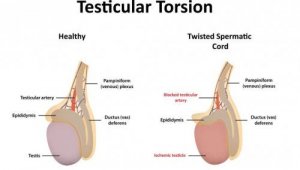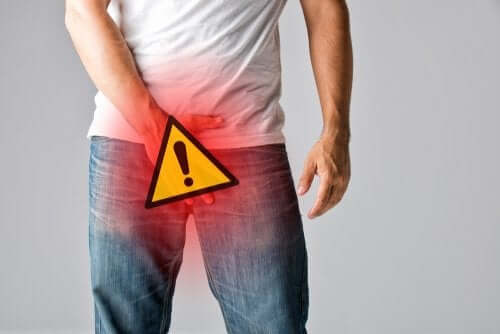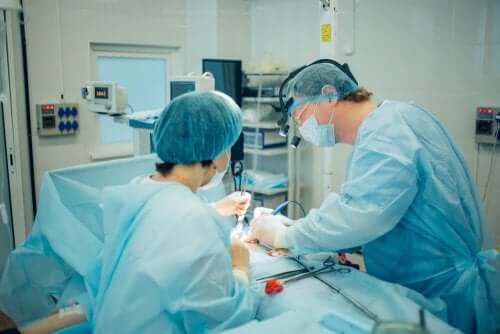Testicular Torsion: Symptoms and Causes

Testicular torsion is a condition that occurs when the spermatic cord, which holds the testicles in the scrotum, twists. This interrupts the blood supply to the testicles and surrounding tissue.
The testicles are glands that produce sperm. They’re egg-shaped and located in the scrotal sac.
The blood supply to the testicles comes from the testicular arteries that come through the spermatic cord. Meanwhile, venous return occurs via the spermatic veins that follow the same path but in reverse. Testicular torsion obstructs these blood vessels, which leads to a lack of blood flow in the testicle that, if prolonged, may result in it having to be removed.
Causes of testicular torsion

Certain anatomical shapes may favor a greater predisposition to suffering from this condition.
Testicular torsion can occur at any age; it can even occur in older men. However, it’s more common during puberty or during the neonatal period. Some men are more prone to suffering from testicular torsion due to defects in the connective tissue of the scrotum. However, there’s no clear cause.
This condition may occur after an injury to the scrotal area that produces a lot of inflammation. In addition, it can also occur after performing vigorous exercise. In some cases, there’s an anatomic predisposition that allows the testicles to rotate freely in the scrotum. It may also be because the spermatic cord is longer than normal.
The symptoms of testicular torsion
Pain is the main symptom; it’s characterized by being sudden and severe. Although the pain is located in the affected testicle, it may radiate to the groin area. It can even reach the lower abdomen.
Other symptoms that may accompany the pain are:
- Nausea
- Vomiting
- General discomfort
In some cases, the testicle may be higher than normal or at an unusual angle. Generally, the affected testicle is swollen, and the skin of the scrotum is red and hardened.
The intensity of these symptoms depends on how long the man has been suffering from the condition. However, sometimes, testicular torsion can resolve on its own and the pain disappears gradually.
You should also read: How to Avoid Fluid Retention and Reduce Swelling
Diagnosis of testicular torsion
A doctor can diagnose testicular torsion by analyzing the patient’s medical history and doing a physical examination. An ultrasound scan is the imaging test that confirms the diagnosis. However, it isn’t always necessary.
An ultrasound scan shows that there’s decreased blood flow to the testicle. Doctors indicate this test if they’re unsure of the diagnosis.
This article may interest you: Dry Orgasm: What Is it and Why Does it Happen?
Treatment

Surgery is the most common treatment to attach both testicles to the inside of the scrotum.
This problem is a surgical emergency and time is of the essence. This is because the more time passes, the greater the risk of testicular necrosis and the need for removal. If doctors perform the surgery within the first six hours, it’s likely that the testicle can be saved.
If a child complains of sudden testicular pain, it’s advisable to seek medical attention immediately. The treatment consists of undoing the twisting, as well as subsequent fixation of the affected testicle.
In some cases when there’s a lot of swelling and surgery can’t be performed immediately, the twisting can be corrected manually. However, doctors should still perform surgery as soon as possible.
If doctors detect the condition early and treat it promptly, the testicle can still work properly. The odds of the testicle needing to be removed increase if blood flow is interrupted for more than six hours. However, sometimes the testicle may lose its ability to function.
All cited sources were thoroughly reviewed by our team to ensure their quality, reliability, currency, and validity. The bibliography of this article was considered reliable and of academic or scientific accuracy.
- Sanz Jaka, J. P., Villanueva, J. A., Garmendia Larrea, J. C., Mendívil Dacal, J., & Arocena Lanz, F. (1989). Torsión del cordón espermático. Archivos Espanoles de Urologia.
- Mongiat-Artus, P. (2012). Torsión del cordón espermático y de los anexos testiculares. EMC – Urología. https://doi.org/10.1016/s1761-3310(04)40737-3
- Gonzalo-González, A., Longás, J., Pérez-Barrero, P., Infantes, M., Pérez-Alfranca, C., & Ruiz-Pérez, R. (2007). Bloqueo del cordón espermático como tratamiento del dolor crónico testicular. Revista de La Sociedad Espanola Del Dolor.
This text is provided for informational purposes only and does not replace consultation with a professional. If in doubt, consult your specialist.








